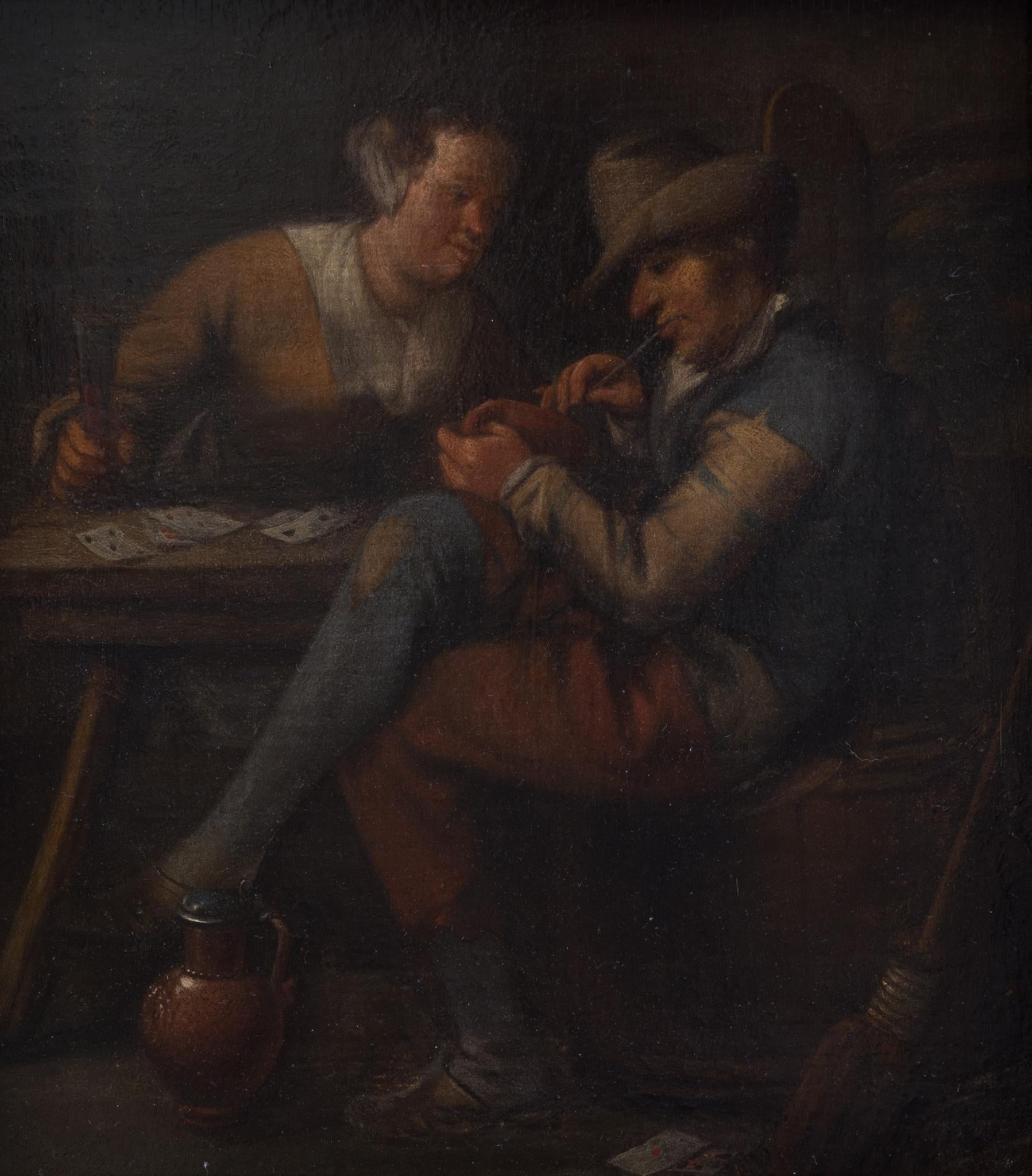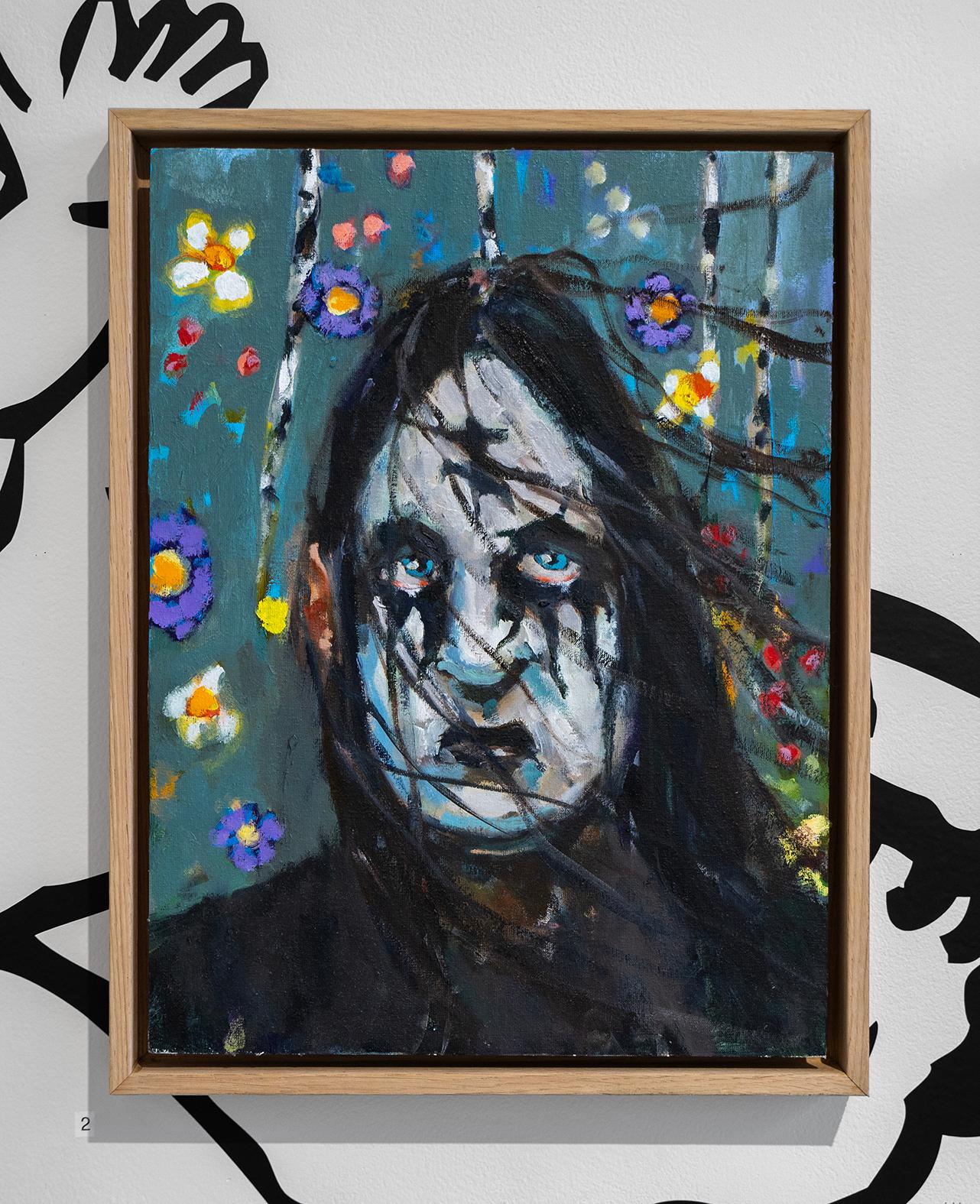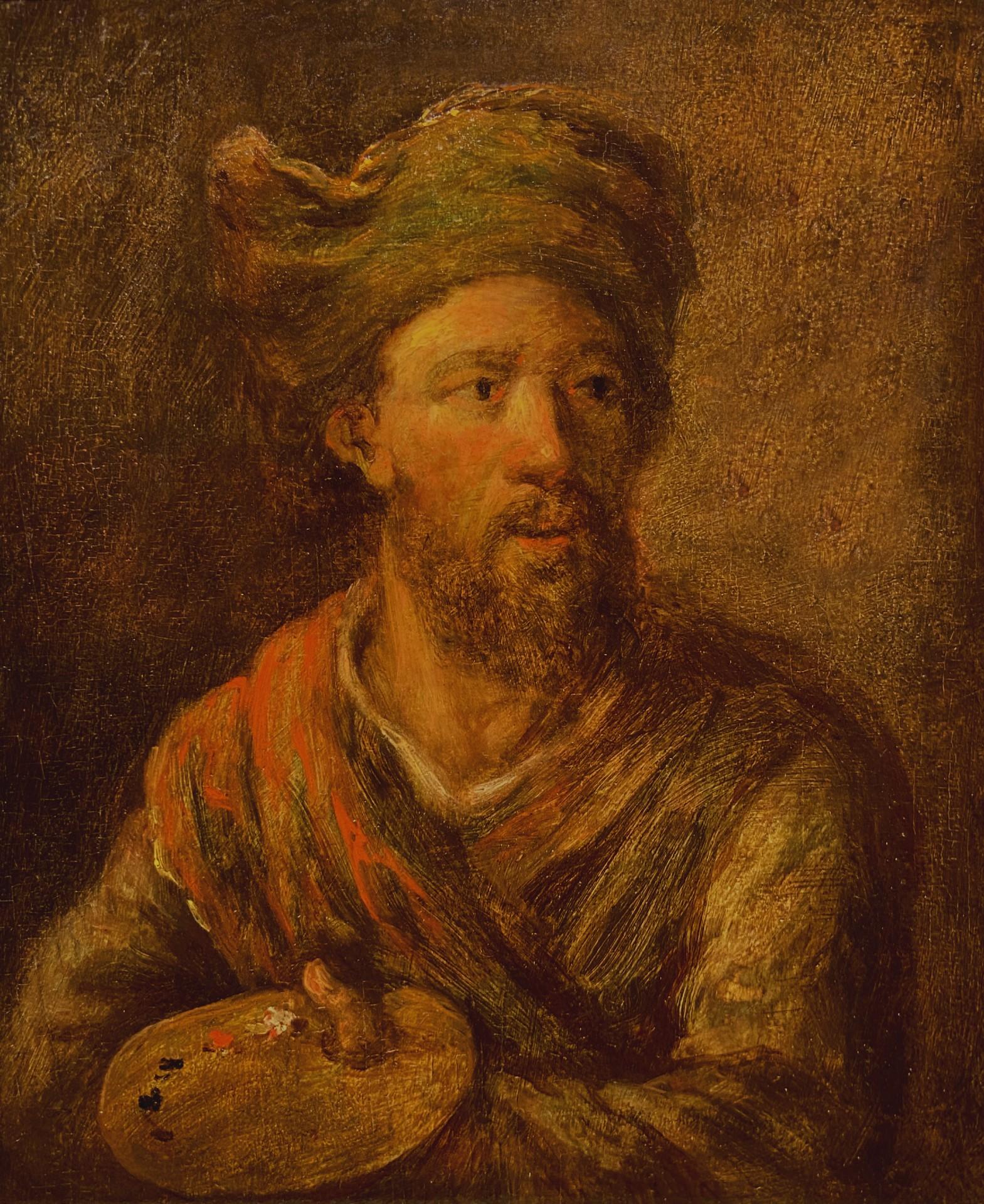Items Similar to Portrait of a Trepanning Surgeon, Early 17th Century Oil Painting
Want more images or videos?
Request additional images or videos from the seller
1 of 9
Habsburg SchoolPortrait of a Trepanning Surgeon, Early 17th Century Oil Painting
About the Item
Oil on oak panel, inscribed top left ‘AETATIS SUAE 32’
Image size: 27 x 35 inches (68.5 x 89 cm)
Contemporary style handmade frame
This is a portrait of a medical figure from the early 17th century Habsburg Empire. The man is standing holding a trepanation instrument and is accompanied by a skull. At the time of its painting trepanation was a novel practice that was on the cutting edge of medicine, having received fame after the process was performed successfully on Phillip II Spain’s son.
The man is dressed in black, the colour of choice in the Low Countries during this period. To the modern eye, his clothing appears to be relatively sombre, but on closer inspection, it is apparent that the artist has conveyed the elevated status of his sitter through bringing out the differing textures of the material that make up his costume. There was no medical dress in this period but the high fashion is suggestive of someone who was high status - indeed many of these doctors became nobles.
The heraldry in the top right hand corner of the work places the sitter in the United Provinces. On the coat of arms the eagle emerging from a division per pale (the vertical) is commonly known as a Frisian eagle and the rest of the composition is very much from the Low Countries. The presence of the tulips illustrates that the sitter lived late in the seventeenth century.
- Creator:Habsburg School (1600 - 1700, Dutch)
- Dimensions:Height: 35 in (88.9 cm)Width: 27 in (68.58 cm)
- More Editions & Sizes:1 of 1 Price: $53,624
- Medium:
- Period:Early 17th Century
- Condition:
- Gallery Location:London, GB
- Reference Number:1stDibs: LU52412633552
About the Seller
5.0
Vetted Seller
These experienced sellers undergo a comprehensive evaluation by our team of in-house experts.
Established in 2007
1stDibs seller since 2014
64 sales on 1stDibs
Typical response time: 2 hours
- ShippingRetrieving quote...Ships From: London, United Kingdom
- Return PolicyA return for this item may be initiated within 14 days of delivery.
More From This SellerView All
- Self Portrait, Oil on Oak Panel, English School, Handmade FrameLocated in London, GBOil on oak panel Image size: 9 x 7 1/4 inches (23 x 18.5 cm) Period style hand made frame This is a self-portrait is most likely by a 17th century English...Category
17th Century Portrait Paintings
MaterialsOil, Oak
- Possible Portrait of William ShakespeareLocated in London, GBOil on oak panel Image size: 17 1/4 x 22 1/4 inches (44 x 56.5 cm) Period oak frame This is a portrait of a Tudor gentleman in an open next shirt with one hand raised to his chest. ...Category
16th Century Portrait Paintings
MaterialsOil, Oak
- The Distraction, Late 19th Century Oil Painting, OrientalistLocated in London, GBWalter Charles Horsley 1855 – 1921 The Distraction Oil on canvas, signed lower left Image size: 25 x 20 1/2 inches (63.5 x 52 cm) Orientalist ha...Category
Late 19th Century Portrait Paintings
MaterialsOil, Canvas
- Portrait of a Girl, 17th Century English School Old Masters OilBy Gilbert JacksonLocated in London, GBGilbert Jackson English Active: 1620 - 1650 Portrait of a Girl Oil on panel, signed upper left and Inscribed upper right Image size: 24 ½ x 20 inches Contemporary style hand made...Category
17th Century Old Masters Portrait Paintings
MaterialsOil
- The Blue Headdress, Group Portrait Orientalist Oil Painting, Signed and DatedBy Emile DeckersLocated in London, GBÉmile Deckers 1885 - 1968 The Blue Headress Oil on canvas, signed lower left, inscribed and dated "Algers, 1958" Image size: 26 x 33 inches (66 x 84 cm) Hand made Orientalist gilt f...Category
1950s Portrait Paintings
MaterialsCanvas, Oil
- Portrait of William Herbert, 3rd Earl of Pembroke, Early 17th Century PortraitLocated in London, GBEnglish School, (circa 1600) Portrait of William Herbert, 3rd Earl of Pembroke Oil on panel, oval Image size: 29¼ x 23⅞ inches Painted wooden frame Provenance: 176, Collection of Francis Greville, 1st Earl of Warwick. The Trustees of the Lord Brooks’ Settlement, (removed from Warwick Castle). Sotheby’s, London, 22nd March 1968, lot 81. Painted onto wooden panel, this portrait shows a dark haired gentleman in profile sporting an open white shirt. On top of this garments is a richly detailed black cloak, decorated with gold thread and lined with a sumptuous crimson lining. With the red silk inside it’s all very expensive and would fall under sumptuary laws – so this is a nobleman of high degree. It’s melancholic air conforms to the contemporary popularity of this very human condition, evident in fashionable poetry and music of the period. In comparison to our own modern prejudices, melancholy was associated with creativity in this period. This portrait appeared in the earliest described list of pictures of Warwick castle dating to 1762. Compiled by collector and antiquary Sir William Musgrave ‘taken from the information of Lord & Lady Warwick’ (Add. MSS, 5726 fol. 3) is described; ‘8. Earl of Essex – an original by Zuccharo – seen in profile with black hair. Holding a black robe across his breast with his right hand.’ As tempting as it is to imagine that this is a portrait of Robert Devereux, the 2nd Earl Essex, we might take this with a pinch of salt. Its identification with this romantic and fatal Elizabethan might well have been an attempt to add romance to Warwick Castle’s walls. It doesn’t correspond all that well with Essex’s portraits around 1600 after his return from Cadiz. Notably, this picture was presumably hung not too far away from the castle’s two portraits of Queen Elizabeth I. The first, and undoubtedly the best, being the exquisite coronation portrait that was sold by Lord Brooke in the late 1970s and now hangs in the National Portrait Gallery. The second, described as being ‘a copy from the original at Ld Hydes’, has yet to resurface. The portrait eventually ended up being hung in the State Bedroom of Warwick Castle. Archival documents present one other interesting candidate. The Greville family’s earliest inventory of paintings, made in 1630 at their home Brooke House in Holborn, London, describes five portraits of identified figures. All five belonged to the courtier, politician and poet Sir Fulke Greville (1554-1628), 1st Baron Brooke, and were hung in the ‘Gallerie’ of Brooke House behind yellow curtains. One of them was described as being of ‘Lord of Pembrooke’, which is likely to have been William Herbert (1580-1630), 3rd Earl of Pembroke. William was the eldest son of Greville’s best friend’s sister Mary Sidney, and was brought up in the particularly literary and poetically orientated household which his mother had supported. Notably, the 3rd Earl was one of the figures that Shakespeare’s first folio was dedicated to in 1623. The melancholic air to the portrait corresponds to William’s own pretensions as a learned and poetic figure. The richness of the robe in the painting, sporting golden thread and a spotted black fabric, is indicative of wealth beyond that of a simple poet or actor. The portrait’s dating to around the year 1600 might have coincided with William’s father death and his own rise to the Pembroke Earldom. This period of his life too was imbued with personal sadness, as an illicit affair with a Mary Fitton had resulted in a pregnancy and eventual banishment by Elizabeth I to Wilton after a short spell in Fleet Prison. His illegitimate son died shortly after being born. Despite being a close follower of the Earl of Essex, William had side-stepped supporting Devereux in the fatal uprising against the Queen and eventually regained favour at the court of the next monarch James I. His linen shirt is edged with a delicate border of lace and his black cloak is lined on the inside with sumptuous scarlet and richly decorated on the outside with gold braid and a pattern of embroidered black spots. Despite the richness of his clothes, William Herbert has been presented in a dishevelled state of semi-undress, his shirt unlaced far down his chest with the ties lying limply over his hand, indicating that he is in a state of distracted detachment. It has been suggested that the fashion for melancholy was rooted in an increase in self-consciousness and introspective reflection during the late 16th and early 17th centuries. In contemporary literature melancholy was said to be caused by a plenitude of the melancholy humor, one of the four vital humors, which were thought to regulate the functions of the body. An abundance of the melancholia humor was associated with a heightened creativity and intellectual ability and hence melancholy was linked to the notion of genius, as reflected in the work of the Oxford scholar Robert Burton, who in his work ‘The Anatomy of Melancholy’, described the Malcontent as ‘of all others [the]… most witty, [who] causeth many times divine ravishment, and a kind of enthusiamus… which stirreth them up to be excellent Philosophers, Poets and Prophets.’ (R. Burton, The Anatomy of Melancholy, London, 1621 in R. Strong, ‘Elizabethan Malady: Melancholy in Elizabethan and Jacobean Portraits’, Apollo, LXXIX, 1964). Melancholy was viewed as a highly fashionable affliction under Elizabeth I, and her successor James I, and a dejected demeanour was adopted by wealthy young men, often presenting themselves as scholars or despondent lovers, as reflected in the portraiture and literature from this period. Although the sitter in this portrait is, as yet, unidentified, it seems probable that he was a nobleman with literary or artistic ambitions, following in the same vain as such famous figures as the aristocratic poet and dramatist, Edward de Vere...Category
Early 17th Century Old Masters Portrait Paintings
MaterialsWood Panel, Oil
You May Also Like
- The Card Players by a Flemish 1600s ArtistBy Flemish School, 17th CenturyLocated in Stockholm, SEFlemish 1600s School The Card Players oil on oak panel panel dimensions 22.5 x 20 cm frame included Provenance: From a Swedish private collection. Condition: Flat and stabl...Category
17th Century Old Masters Figurative Paintings
MaterialsOak, Oil, Panel
- Metal fan (Blue)Located in Oslo, 03Oil painting on masoniteCategory
2010s Contemporary Portrait Paintings
MaterialsOak, Masonite, Oil
- Maxwell Ashby Armfield Portrait Of The Artist's Mother Margaret Armfield MaxwellBy Maxwell Ashby ArmfieldLocated in Blackwater, GBPortrait Of the Artists Mother, MAXWELL ASHBY ARMFIELD (1882-1972) Portrait of the artist's mother, Margaret Armfield née Maxwell, depicted full length in a mock entourage with t...Category
20th Century Portrait Paintings
MaterialsPanel, Oak, Tempera
- Portrait of Senator Bartolomeo Panciatichi by Santi di Tito (1574)Located in PARIS, FRThis recently rediscovered portrait of Santi di Tito depicts a Florentine senator, with a letter in his hand indicating that the painting was executed in 1574 when the sitter was 66 years old. On the basis of these clues, it is tempting to view it as a portrait of Bartolomeo Panciatichi, who was painted some thirty years before by Bronzino (1503 - 1572). While the treatment of the hands recalls the Florentine tradition of Mannerist portraits, the comparison with Bronzino's portrait illustrates Santi di Tito's search for greater realism, despite the stereotyped composition. 1. Santi di Tito, Counter-Reformation painter and portraitist Santi di Tito was the great painter of the Florentine Counter-Reformation. He proposed a new artistic language that broke away from Mannerism. Little is known about his training in Florence (perhaps alongside Bronzino or Baccio Bandinelli), but this period of training enabled him to join the Company of Saint Luke, the guild of Florentine painters, in 1554. Between 1560 and 1564, Santi di Tito spent time in Rome, where he frequented the workshop of Taddeo Zuccari. This stay had a fundamental influence on his work, thanks to the discovery of the late work of Raphael, but also his encounters with the painters Francesco Salviati and Federico Barocci. Around 1565, Santi di Tito returned to Florence, where he remained until the end of his life, dividing his talents between the creation of important religious paintings and countless portraits. He became one of the city's leading painters, distinguishing himself, in particular, in the creation of large religious compositions in which the spirit of the Counter-Reformation was reflected. In 1568, Santi di Tito became a member of the Confraternity of Saint Thomas Aquinas...Category
16th Century Old Masters Portrait Paintings
MaterialsPoplar, Oil
- "The Walk Back Home" A Monumental "Exhibition" Painting by Carl LaschLocated in New York, NYCarl Lasch (1822-1888 German) "The Walk Back Home" A Monumental Exhibition Painting, Oil on canvas laid to masonite in original gilt-wood frame. ...Category
19th Century Portrait Paintings
MaterialsOil, Masonite
- Nadar de nocheBy Julio Alan LepezLocated in New York, NY“Nadar de noche”, 2018 116w x 80h Oil on wood, mdf cut Julio Alan Lepez graduated from the National School of Arts Prilidiano Pueyrredón in 1997. He has been the subject of solo and group exhibitions internationally, including at Museo Municipal de Arte in La Plata, Argentina, Centro Cultural de España in Mexico City, Centro Cultural Recoletta in Buenos Aires, Artemisa Gallery...Category
2010s Contemporary Portrait Paintings
MaterialsWood, Oil
Recently Viewed
View AllMore Ways To Browse
Howard Barron
Mark Beard Canadian Mountie
Mino Maccari At Auction
Mino Maccari On Auction
Samuel Brecher On Sale
Chanel Bubblegum Pink
French Portrait 18 Th Century
Henrietta Herbert
J Dilla
John P Osborne
Sir Thomas Kitson
Duke Of Somerset
Kevin Morris
Sant James
Wisdom Uche
Evil Eye Child
George Gower
Hoppner John





